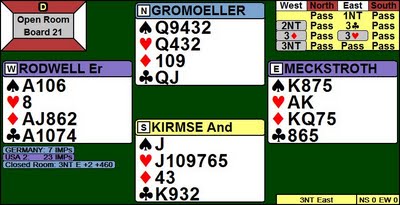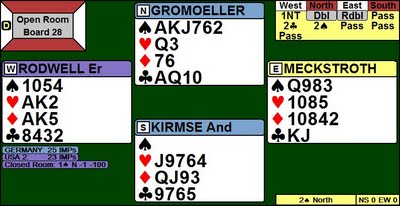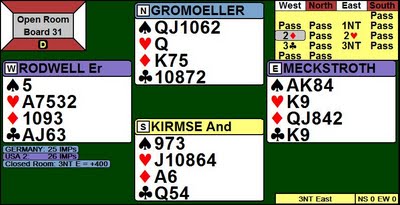Bread N' Butter Part IV
This is Part IV of the Bread N' Butter series: a look at Meckwell bidding in the recent world championship when one of them had 10 to 17 balanced, either in opening position, or directly over an opponent's opening. We will consider balanced as any 4-3-3-3/4-4-3-2/5-3-3-2, plus any hand that Meckwell treated as balanced.
US expert Richard Pavlicek (see RPBridge link on the right for his full site) has an interesting chart of top pro performance:
http://www.rpbridge.net/9x65.htm
One thing to consider for this chart, is that Meckwell almost always play the tough matches and sessions. On day 4 of this year's Bermuda Bowl round robin all the matches were tough, meaning there was no break for Meckwell. They started the day playing the always competitive German squad. This match featured our first look in this series at the Meckwell notrump structure.

.
.
.
.
.
.
On board 21 Meckwell wheeled out one of their favorite gadgets, 1NT-2NT as Puppet Stayman. Compared to using 1NT-3C as Puppet Stayman, 2NT has extra space, and Meckwell use it to handle the 5-4/4-5 in the minors hand, game going, no four card major, and with major suit shortness if just game going values. The theory is that if opener bids a five card major over 2NT Puppet Stayman, then if it hits a three card fit on a 5-4-3-1, they are well placed. Likewise if it hits the singleton of the 5-4-3-1, then there is no 4-4 minor fit for slam purposes, and usually there will be wasted values in the five card major opposite the shortness, and thus 3NT will be a good place to park the contract. Here on this board Rodwell used Puppet Stayman, Meckstroth denied a five card major with 3C, Rodwell showed 5-4/4-5 in the minors game going values with no four card major, 3H asked shortness, and 3NT showed short hearts. Both tables made +460.
On board 28, Rodwell opened a 14-16, and North doubled with good playing value.

.
.
.
.
.
.
Meckwell provided their opponents with one of the best convention cards at the world championships, including 21 supplemental notes. Their convention card can currently be seen here:
http://www.ecatsbridge.com/documents/files/2009Brazil/Systems/bermudabowl/usa2/meckstroth-rodwell.pdf
Note 18 tells us that: "1N comp: … system on over ART X. Over PEN X, XX=C/H or D/S". Since this German pair describe their double as penalty on their convention card, Meckstroth's double showed either the rounded or pointed suits. Rodwell bid clubs in case it was rounded, and North bid two spades only to hit a pointed LHO. This was down two, and in the open room North overcalled one spade over West's one club opening, played there for down one, and that was 3 IMPs to USA2.

.
.
.
.
.
.
On board 31, Rodwell transferred to hearts, then showed clubs with game going values opposite the 14-16, with a hand that is better than its 9 high card points. South led a small spade using 3/5 leads against notrump. It was not clear to Meckstroth on whether to duck two spades or not. He won the second spade trick, and knocked out the diamond ace. South continued spades, and North was able to set the contract when in with the diamond king. At the other table the lead was the spade 7, which gave declarer a better read on the suit layout, and he ducked the first two rounds to bring home +400 and 10 IMPs. This was enough to give German a 35-26 win, 17-13 in victory points.
This is Part IV of the Bread N' Butter series: a look at Meckwell bidding in the recent world championship when one of them had 10 to 17 balanced, either in opening position, or directly over an opponent's opening. We will consider balanced as any 4-3-3-3/4-4-3-2/5-3-3-2, plus any hand that Meckwell treated as balanced.
US expert Richard Pavlicek (see RPBridge link on the right for his full site) has an interesting chart of top pro performance:
http://www.rpbridge.net/9x65.htm
One thing to consider for this chart, is that Meckwell almost always play the tough matches and sessions. On day 4 of this year's Bermuda Bowl round robin all the matches were tough, meaning there was no break for Meckwell. They started the day playing the always competitive German squad. This match featured our first look in this series at the Meckwell notrump structure.
.
.
.
.
.
.
On board 21 Meckwell wheeled out one of their favorite gadgets, 1NT-2NT as Puppet Stayman. Compared to using 1NT-3C as Puppet Stayman, 2NT has extra space, and Meckwell use it to handle the 5-4/4-5 in the minors hand, game going, no four card major, and with major suit shortness if just game going values. The theory is that if opener bids a five card major over 2NT Puppet Stayman, then if it hits a three card fit on a 5-4-3-1, they are well placed. Likewise if it hits the singleton of the 5-4-3-1, then there is no 4-4 minor fit for slam purposes, and usually there will be wasted values in the five card major opposite the shortness, and thus 3NT will be a good place to park the contract. Here on this board Rodwell used Puppet Stayman, Meckstroth denied a five card major with 3C, Rodwell showed 5-4/4-5 in the minors game going values with no four card major, 3H asked shortness, and 3NT showed short hearts. Both tables made +460.
On board 28, Rodwell opened a 14-16, and North doubled with good playing value.
.
.
.
.
.
.
Meckwell provided their opponents with one of the best convention cards at the world championships, including 21 supplemental notes. Their convention card can currently be seen here:
http://www.ecatsbridge.com/documents/files/2009Brazil/Systems/bermudabowl/usa2/meckstroth-rodwell.pdf
Note 18 tells us that: "1N comp: … system on over ART X. Over PEN X, XX=C/H or D/S". Since this German pair describe their double as penalty on their convention card, Meckstroth's double showed either the rounded or pointed suits. Rodwell bid clubs in case it was rounded, and North bid two spades only to hit a pointed LHO. This was down two, and in the open room North overcalled one spade over West's one club opening, played there for down one, and that was 3 IMPs to USA2.
.
.
.
.
.
.
On board 31, Rodwell transferred to hearts, then showed clubs with game going values opposite the 14-16, with a hand that is better than its 9 high card points. South led a small spade using 3/5 leads against notrump. It was not clear to Meckstroth on whether to duck two spades or not. He won the second spade trick, and knocked out the diamond ace. South continued spades, and North was able to set the contract when in with the diamond king. At the other table the lead was the spade 7, which gave declarer a better read on the suit layout, and he ducked the first two rounds to bring home +400 and 10 IMPs. This was enough to give German a 35-26 win, 17-13 in victory points.

1 Comments:
At 8:35 PM, Larry said…
Larry said…
Simple me, I use the rule of 7 and duck spades twice, making 3NT.
Post a Comment
<< Home